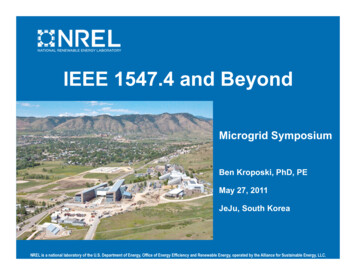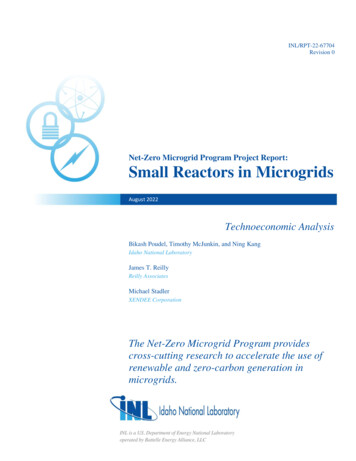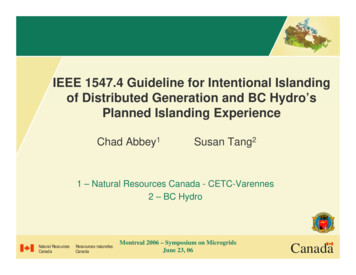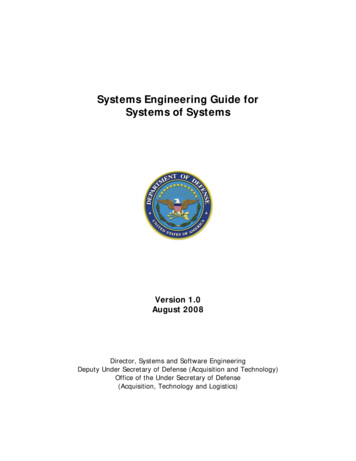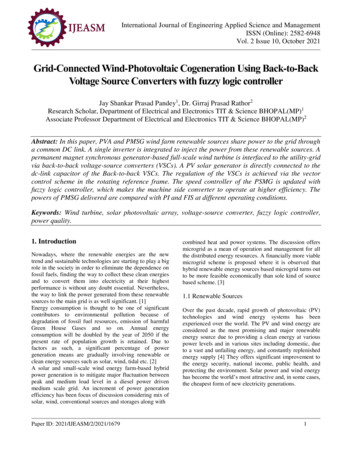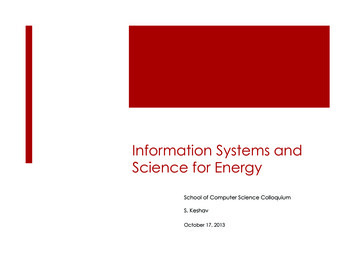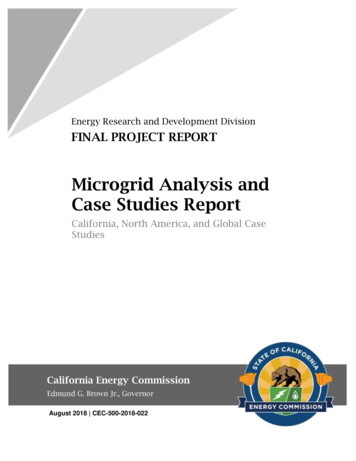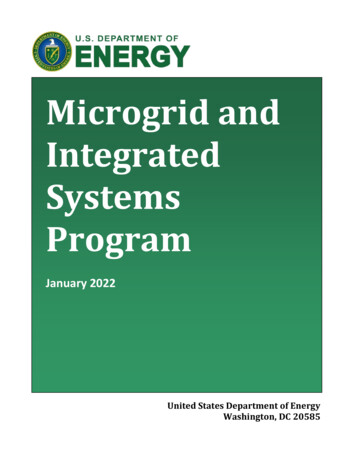
Transcription
Microgrid andIntegratedSystemsProgramJanuary 2022United States Department of EnergyWashington, DC 20585
Executive SummaryMicrogrids serve as an effective platform for integrating distributed energy resources (DERs)and achieving optimal performance in reduced costs and emissions while bolstering theresilience of the nation’s electricity system. The value of microgrids is further enhanced withissuance of FERC Order 2222, under which the DERs that are aggregated and optimized inmicrogrids not only can participate in wholesale energy markets but are able to realize more oftheir maximum potential benefits. As climate-related natural disasters become more frequentand severe, along with greater electrification, microgrids will serve as increasingly valuableresources in support of power system resilience.A driving force behind DOE’s microgrid efforts is the Office of Electricity (OE), whichcollaborates with other DOE offices, the national laboratory complex, state energy offices,utility regulators, and a broad network of public-private microgrid stakeholders. DOE’s remotemicrogrid research has primarily targeted applications in Alaska, where multiple deploymentshave made significant progress in demonstrating technical solutions for resilient operations andhave provided reference systems to plan resilient microgrids elsewhere. DOE’s microgrids forcritical infrastructure research has centered on microgrid design and analysis tools. Thesedesign resources provide reliable cost and resilience estimates of microgrid investments, andare being continually improved through diverse applications, such as disaster recovery inPuerto Rico and Texas, and microgrid resilience at critical transit hubs. While DOE has madesignificant progress in supporting microgrid deployments, there remain research gaps for bothremote microgrid, and microgrids for critical infrastructure, which are being addressed incurrent DOE collaborations and are discussed in this report.
Department of Energy January 2022Microgrid and Integrated Microgrid SystemsProgramTable of ContentsI.Introduction . 1II.Outcomes and Opportunities for Integrated Microgrid Systems for Isolated Communities . 2III.Outcomes and Opportunities for Microgrid Systems to Increase the Resilience of CriticalInfrastructure . 6IV.Conclusions . 9Microgrid and Integrated Microgrid Systems Program Page ii
Department of Energy January 2022I.IntroductionDOE’s work in microgrid systems for isolated communities and for critical infrastructure drawson significant collaboration, and ranges from microgrid research and development (R&D) totechnical assistance in applying emerging microgrid tools. The R&D focuses on improvingresilience, reliability, and sustainability of electricity delivery system through advancedmicrogrid development, including developing and testing use cases to promote energy equityand justice, whereas microgrid demonstrations and technical assistance aim to supportequitable energy transition through prioritized provision of at least 40 percent of microgridbenefits going to disadvantaged communities.A driving force behind DOE’s microgrid efforts is the Office of Electricity (OE), whichcollaborates with other DOE offices including the Arctic Energy Office, the Office of EnergyEfficiency and Renewable Energy, and the Office of Indian Energy Policy and Programs to worktogether and support a range of efforts in research and technology demonstration andtechnical support for communities. OE also works closely with the national laboratory complex,the National Association of State Energy Offices (NASEO), utility regulators through the NationalAssociation of Regulatory Utility Commissioners (NARUC), and specific state energy offices suchas the Alaska Energy Authority. Through participation in many other partnerships, DOE isconnected to a far-reaching network of public-private microgrid stakeholders.DOE’s remote microgrid research has primarily targeted applications in Alaska, where multipledeployments have made significant progress in demonstrating technical solutions for resilientoperations and have provided reference systems to plan resilient microgrids elsewhere. TheUnited States Agency for International Development has also taken advantage of DOEdeveloped expertise in their remote microgrid work in Africa 1, Haiti 2, and other rural andremote communities, which has provided valuable insight on technical, regulatory, andprocedural rollout of microgrids in the United States. Recently, DOE announced the EnergyTransitions Initiative Partnership Project, which provides technical assistance to communitieslooking for support in planning and developing remote microgrids.Outcomes from DOE projects around remote microgrids have indicated a greater need for: Institutional support programs that facilitate knowledge and data exchange, datasharing resources, supportive policy and regulatory models, development strategies,and wider-scale coordination. Microgrid designs that consider heating, cooling, transportation, resilience,interconnected systems, and high contributions from renewable energy.DOE’s microgrids for critical infrastructure research has centered on microgrid design andanalysis tools. These design resources provide reliable cost and resilience estimates rogrid and Integrated Microgrid Systems Program Page 1
Department of Energy January 2022microgrid investments, and have been developed through numerous DoD and militarypartnerships. DOE’s design tools are being continually improved through diverse applications,such as disaster recovery in Puerto Rico and Texas, and microgrid resilience at critical transithubs.Across DOE microgrid projects for critical infrastructure, the following research needs havebeen recommended, and are the subject of current and forward-looking efforts. Detailed, site-specific microgrid feasibility studiesQuantifiable, standardized, multi-criteria assessments of microgrid performance forcritical infrastructureSupportive ownership and regulatory conditions of microgrid deploymentsThe Outcomes and Opportunities sections below explains DOE progress in addressing theresearch progress and R&D needs of both microgrid categories requested of this report. WhileDOE has made significant progress in supporting microgrid deployments, there remain researchgaps for both remote microgrids, and microgrids for critical infrastructure. The Conclusionsection then summarizes the findings and future efforts at the end of this report.II. Outcomes and Opportunities for IntegratedMicrogrid Systems for Isolated CommunitiesMore than 1,500 remote communities within the circumpolar Arctic, including many locationsin Alaska, are served by microgrids. These communities are mostly dependent on importedfossil energy for electricity, transportation, heating, and other critical services such as potablewater, and are therefore important locations to develop clean, resilient, and affordablemicrogrid solutions that apply modern controls and utilize cleaner energy generation sources.Microgrids have been deployed in rural and indigenous communities in Alaska since the 1960s.That six-decade history of innovation in bringing power to remote and underservedcommunities provides significant experience that can be leveraged around the world to meetelectrification and resilience goals with microgrids.Lessons from Alaska and remote or island communities are applicable throughout the energysector, as microgrids become recognized for improved resilience and efficiency. A recent studyby the World Bank Energy Sector Management Assistance Program group suggests thatminigrid/microgrid power systems could provide services to almost half a billion people by2030 3—a large growth area that could draw directly on experience built in the United /10986/31926Microgrid and Integrated Microgrid Systems Program Page 2
Department of Energy January 2022DOE has undertaken extensive work to address energy issues in isolated communities. Effortshave largely focused on communities in Alaska but include work in smaller islandedcommunities in the Northeast with a focus on Maine, the Pacific with a focus in Hawaii and theU.S. Pacific Territories, the Caribbean with a focus on U.S. Territories, and Tribal lands that donot have grid connection. This work has been implemented across Federal agencies, stategovernments, academic institutions, and community non-government organizations in closecollaboration with local energy-serving organizations, typically municipal service providers andenergy cooperatives. DOE has provided most of the research investment in these efforts.Central among these efforts is the Arctic Lab Partnership, which serves to organize researchoutcomes and direction across a coalition of remote microgrid offices and organizations. TheArctic Lab Partnership recently summarized the following research needs for Arctic microgrids,with relevance for other remote microgrid systems: Higher detail information on community energy needs and local resources. This couldbuild on existing resources such as the Alaska Energy Data Gateway, Alaska AffordableEnergy Strategy Model, and the Alaska Renewable Energy Atlas to provide higher qualityassessments of resources and community loads.Better standardization around energy system designs and development, includingdocumentation of development pathways, performance standards, and technologyoptions.Supportive policy, funding, and collaborative development models. Energy systems arecapital intensive, so policy is needed to articulate the investments using public andprivate partnerships, to implement an energy transformation in rural Alaska.Global knowledge exchange with islanded and isolated communities around the world.Initial investments in this type of collaboration include the Island Grid Resource Centerand the Arctic Remote Energy Networks Academy, but greater collaboration could beuseful to more rapidly advance the science of microgrids in remote places.Expanded research coordination, including standard forums to support microgridcollaboration with a focus on isolated, islanded, and remote communities.Microgrid design that supports heating, cooling, and transportation, and with relativelyhigh contributions from renewable energy. The communities of Kodiak and KongiganakAlaska are working to address heating on a community scale using renewable energytechnologies—these and similar projects were implemented through Alaska RenewableEnergy Funds, which although largely successful, have not included funding to supportwider learning, project documentation, and support for project innovation andimprovement.These research needs can be categorized broadly as institutional support and microgrid design.Institutional support refers to information exchange, supportive policy frameworks, datasharing and standardization. The following DOE Alaska projects are helping to advanceinstitutional support for remote microgrids.Microgrid and Integrated Microgrid Systems Program Page 3
Department of Energy January 2022 Alaska Microgrid Partnership (AMP)—An effort within DOE’s Grid ModernizationLaboratory Consortium to develop more systemized, modular, and scalabledevelopment and deployment concepts that could be widely implemented acrosscommunities with different energy needs and community readiness. Work has focusedon developing a holistic, all-energy approach with technical and financial replicability asa key component.The Energy Transitions Initiative (ETI)—Implemented by DOE in 2020, ETI builds ondecades of earlier DOE efforts such as the Islands Energy Playbook and the DOE-fundedIsland Grid Resource Center to further advance self-reliant island and remotecommunities through the development of resilient energy systems. Microgrid planningand deployment are programmatic focus areas executed between communities andnational lab technical experts, under the recently established Energy TransitionsInitiative Partnership Project (ETIPP). Other opportunities to expand technical assistanceand increase local capacity in remote communities are being explored within ETIPP andETIPP-like expansions.Alaska Regional Collaboration for Technology Innovation & Commercialization(ARCTIC)—A collaborative project to build local capacity and support a thriving economythrough resilience research, technology development and deployment, and educationcentered on energy and related industries such as water, food, manufacturing, andtransportation. The overarching objectives are to demonstrate that 50 percentpenetration of variable renewable energy on microgrids is technically and economicallyfeasible, to enhance local sustainability by extending and leveraging local know-how,and support the diversification of Alaska’s ecosystem.Microgrid design research refers to technical innovations, design strategies, renewableintegration solutions, development pathways, and the sharing of these approaches. DOEprojects that are contributing to improved remote microgrid designs include the following. Resilient Alaskan Distribution system Improvements using Automation, Networkanalysis, Control, and Energy storage (RADIANCE)—A project within the DOE GridModernization Laboratory Consortium, RADIANCE involves regional field validations ofresilience methods for distribution grids under harsh weather, cyber-threats, anddynamic grid conditions. These resilience methods use multiple networked microgrids,energy storage, and early-stage grid technologies such as micro-phasor measurementunits (PMUs). This will cultivate a better fundamental understanding of microgridresilience by using a resilience-by-design approach.Development and Validation of Models to Assess the Dynamic Response of ConverterDominated Power Systems Across Multiple Spatiotemporal Scales—With funding fromDOE EPSCoR (Established Program to Stimulate Competitive Research) to support earlystage research, this project is performing dynamic modeling of converter-dominatedpower systems, including at the microgrid scale.Connecting Alaska Remote Villages using Energy Storage Ready Medium Voltage DCInterties—This project explores the economics, topologies, and control strategies forMicrogrid and Integrated Microgrid Systems Program Page 4
Department of Energy January 2022 using cable-based medium voltage direct current (MVDC) interties as an energy storagebased alternative to traditional overhead medium voltage alternating currentdistribution.The Assessment of marine hydrOkinetic-based reliable and Resilient eleCtrification inAlaska (ORCA)—ORCA utilizes MVDC connectivity among remote microgrids in Alaska.The objective of ORCA is to resiliently operate regional and remote microgrids in coastalAlaska under harsh weather, cyber-threats, and dynamic grid conditions. The projectalso aims to develop a cost-effective solution to enhance the resilience of connectedmicrogrids. This project will support equity and economic development for remote andtribal communities.The MIRACL (Microgrids, Infrastructure Resilience, and Advanced Controls Launchpad)project implemented by the Wind Energy Technology Office, along with other DOEoffices, supports innovative work in microgrid systems with a focus on grid andmicrogrid integration of wind energy technology with other DERs. The project willdevelop controls, cybersecurity, and valuation of multi-technology, high renewableenergy power systems, and will define system design requirements to enable wind todeliver on-site power in grid-connected and both islanded and isolated microgridsettings.The Grid Resiliency with a 100% Renewable Microgrid project, funded by the SolarEnergy Technologies Office, in collaboration with other DOE offices, will research andvalidate microgrid technologies that enable the use of solar and other distributedenergy resources (DER) with grid-forming inverters. These devices can improve gridstability and resilience. The project will develop new controls and software for smartinverters and DER management systems that may allow more flexibility for small-scalePV and other DER systems.Additionally, OE leads efforts to research, develop, and demonstrate microgrids asinterconnected building blocks of a future power grid to enhance grid resilience and efficiency.These interconnected microgrid building blocks can improve power system resilience throughreconfiguration and seamless dis- and re-connection. While real-system demonstrations areneeded to advance the concept of these dynamic microgrids, or “dynagrids,” the following DOEefforts have made progress in developing dynamic microgrid controls and operations. OE’s Networked Microgrids research is taking the first step towards microgrids asbuilding blocks by developing an optimization-based microgrid design tool 4 and asystem restoration tool 5 for distribution systems that contain multiple microgrids thatcan be networked. It also includes an effort to demonstrate operation of networkedK.P. Schneider, H. Nagarajan, A. Pratt, et al., “Preliminary Design Process for Networked Microgrids,” TechnicalReport PNNL-30066, June d and Integrated Microgrid Systems Program Page 5
Department of Energy January 2022 microgrids in a distributed manner using collaborative autonomy concepts implementedin an OpenFMB architecture 6.The Autonomous Energy Grids portfolio of research 7 is one example of a DOE-developedinnovation that, though relatively early-stage, could support microgrids operating aspower system building blocks. Autonomous Energy Grids facilitate integration ofrenewables and distributed energy resources (DERs) using distributed and hierarchicalcontrols. In this way, multiple communities can join together to benefit one anotherduring normal operation or become islanded microgrids that autonomously operateduring emergencies and disruptions. This direction is currently further explored in theOE-funded project on Dynamic Microgrids for Real-Time Resilience (DynaGrid), where aflexible definition of microgrids is considered with boundaries adapting to changingoperational conditions and disruptions.In remote communities of Alaska, dynamic interconnection with nearby power systems couldincrease energy supply, including from nearby renewable resources like near-shore wind, solar,and tidal marine hydrokinetics. The added power supply could be used to develop commercialindustries within communities such as aquaculture and provide redundant power forcommunity resilience.From its many projects in remote communities, DOE in collaboration with local partners hasdeveloped insight into multiple angles of remote microgrid operation, including its technical,economic, institutional, and social aspects. Looking ahead, to realize the greatest benefits incost, resilience, and equality for isolated communities and communities everywhere, emphasiswill be placed on sharing these insights to streamline resilient, reliable, and clean microgriddeployments.III. Outcomes and Opportunities for MicrogridSystems to Increase the Resilience of CriticalInfrastructureA variety of existing, growing, and emerging hazards challenge the ability of the bulk powersystem to maintain uninterrupted service to critical electricity loads. As a result, microgrids areoften considered to be a key strategy for improving energy resilience for critical infrastructuresand services, including those that are required for continuity of national security andcommunity functions.For over a decade, DOE has supported analysis to understand the resilience benefits ofmicrogrids serving defense, energy, and other critical infrastructures. DOE has been omorrows-power-grid-will-be-autonomousMicrogrid and Integrated Microgrid Systems Program Page 6
Department of Energy January 2022active in developing microgrid design tools, which have been implemented extensively todetermine the potential benefits, appropriate sizing, security, and functionality of microgridsolutions for critical infrastructure. This effort fulfills the need to provide detailed, reliable, sitespecific microgrid analysis. The DOE-supported Renewable Energy Optimization (REopt) tool developed at theNational Renewable Energy Laboratory is often applied to understand both the specificbill savings and resilience benefits that can be achieved with microgrid solutions forcritical infrastructure:o REopt was used to evaluate how long existing and proposed backup energy systemscould sustain the critical load during an outage at an Army National Guard base. Thisanalysis helped the Army quantify the resilience benefits and trade-offs of a PV-plusstorage system.o REopt has been used to perform an integrated microgrid feasibility analysis for threeU.S. military installations to support U.S. Army energy resilience requirements,resulting in a successful request for proposal for an optimized microgrid design.o REopt analysis informed microgrid design for two Texas Army National Guard sites:Camp Mabry, selected for 2019 DoD funding; and Camp Swift, selected for 2021 DoDfunding. The OE-supported Microgrid Design Toolkit (MDT) and Resilience Node Cluster AnalysisTool (ReNCAT) developed at Sandia National Laboratories helps design and evaluatemicrogrids as resilience investments.o Both the MDT and ReNCAT tools are used within the Critical Infrastructure ResilienceTechnical Assistance project, which delivers direct technical assistance in support ofmicrogrid planning and design for energy resilience at defense critical infrastructurefacilities.o MDT and ReNCAT have been applied to the Puerto Rico system in the aftermath ofHurricane Maria to estimate the social burden caused by a lack of infrastructureservices due to long-duration power outages. In particular, they helped to identifyand design microgrid solutions for clusters of critical services, with an emphasis onthose which could help to minimize the effort that a population must expend toattain all lifeline service.o MDT is currently being used—with REopt and other microgrid evaluation tools—toexplore microgrid designs that can provide energy assurance for criticalinfrastructures. Modeling is currently underway to evaluate the resilience andtechno-economic benefits of microgrid solutions that are designed to serve criticalloads at Kirtland Air Force Base.Microgrid and Integrated Microgrid Systems Program Page 7
Department of Energy January 2022 The Distributed Energy Resources Customer Adoption Model (DER-CAM) developed byLawrence Berkeley National Laboratory with support from OE is a tool to determineoptimal DER parameters (portfolio, sizing, placement, and dispatch), while co-optimizingmultiple value streams for microgrids. DER-CAM applications include resilient designanalysis to meet state and local government requirements.o The DER-CAM-based platform has also been adapted by a commercial entity todemonstrate a standardized approach to guide rapid and repeatable modeling anddesign of secure and resilient microgrids under the DoD Environmental SecurityTechnology Certification Program (ESTCP). 8In order to safely and effectively streamline microgrid deployments, DOE-funded projects areaddressing another research need for critical microgrids. A variety of projects are helping tostandardize and quantify multi-criteria assessments of microgrid performance for criticalinfrastructure. The DOE national laboratory complex is working with critical infrastructure sites andtheir serving energy utilities to generate high-level designs that are appropriate for theU.S. Department of Defense’s Installation Energy Planning process. This effort is rootedin multi-criteria feasibility analysis that weighs the affordability, resilience, sustainability,and security benefits of various microgrid designs.An OE-led microgrid feasibility analysis at the Port of Alaska in Anchorage, one of thebusiest air cargo hubs in the United States, is being used to establish buy-in and developa roadmap toward full microgrid implementation.Another such microgrid feasibility analysis is underway at Naval Station Norfolk. Theproject is leveraging the MDT model to implement a holistic approach to improvingresilience through consequence-focused system analysis and design of electric powerdistribution systems. The work focuses on improving energy resilience of the navalstation in collaboration with the power utility Dominion and other infrastructure utilitiessuch as the local water utility.One result of these feasibility analyses and multi-criteria design efforts is the acknowledgementthat utilities have very little monetary incentive to plan for improved resilience at the point ofservice to military installations. This motivates another research need: clarity aroundownership and regulatory conditions of microgrid deployments. Future work includes makinga value proposition to DOD and to state regulators, exploring whether the cost burden onelectric utility investments that benefit national security should be borne by the ratepayer orthe ndStorage/EW20-52718Microgrid and Integrated Microgrid Systems Program Page 8
Department of Energy January 2022Other important research directions looking ahead will build on current DOE tools to advancethe reliability of feasibility analyses. This will include greater consideration ofinterdependencies with other critical services, more rigorous technical understanding of thereliability of assets, and deeper collaboration with microgrid stakeholders to understandperformance metrics.IV. ConclusionsSeeing the importance of stability and resilience on increasingly distributed and renewableenergy systems, DOE is heavily invested in advancing microgrids for remote communities andcritical infrastructure applications. Out of DOE’s close engagement with partneringorganizations and governments, we have identified research needs for each of the twomicrogrid areas covered under the request.Generally, regulatory and institutional support is an important research direction to supportmicrogrid deployments. Conflicting regulatory decisions for microgrid projects proposed acrossthe country create regulatory uncertainty associated with resilience investments. In somecases, microgrids may be a good technical solution but they cannot overcome regulatory orutility barriers. Clarifying regulatory and ownership approaches is a significant need movingforward, as well as direct DOE collaboration with institutional microgrid stakeholders includingutility commissions, state and local governments, and utilities, to develop balanced and modernmicrogrid regulations at the state and local level.Another general area of necessary research lies in developing industry standards and/or bestpractices for multiple aspects of microgrid design and deployment, such as quantifying theresilience benefits of a given investment, and sharing those best practices to streamlinemicrogrid deployments. Closer knowledge sharing could also result in closer communicationbetween microgrid designers and microgrid stakeholders.In addition, the following research topics have been discussed in this report, along with DOEprojects that target these topics: Better understanding of whole-system interdependencies (e.g., microgrid relation towater system, heating, and transportation fuels)Deeper understanding of community energy needs and local energy resources—taking acommunity-wide approach to addressing needsNew quantitative analysis tools and expansion of current tools for valuing and justifyingmicrogrid investmentsDemonstration and operational research of high-renewable contribution microgridsMore than ever, microgrids are poised to interoperate with an emerging modern grid. With theapproval of FERC Order 2222, microgrids are able to participate in energy markets, driving newuse cases and value propositions. The recent order places new urgency on microgrid designsMicrogrid and Integrated Microgrid Systems Program Page 9
Department of Energy January 2022that are grid-interactive, stable, replicable, and easily deployed. DOE envisions microgrids asbuilding blocks of the future grid that can realize the full value of microgrids across multiplecriteria including grid services. Further research can support microgrid and larger grid designsthat are clean, reliable, and resilient.Microgrid and Integrated Microgrid Systems Program Page 10
Microgrid and Integrated Microgrid Systems Program Page 3 DOE has undertaken extensive work to address energy issues in isolated communities. Efforts have largely focused on communities in Alaska but include work in smaller islanded communities in the Northeast with a focus on Maine, the Pacific with a focus in Hawaii and the
